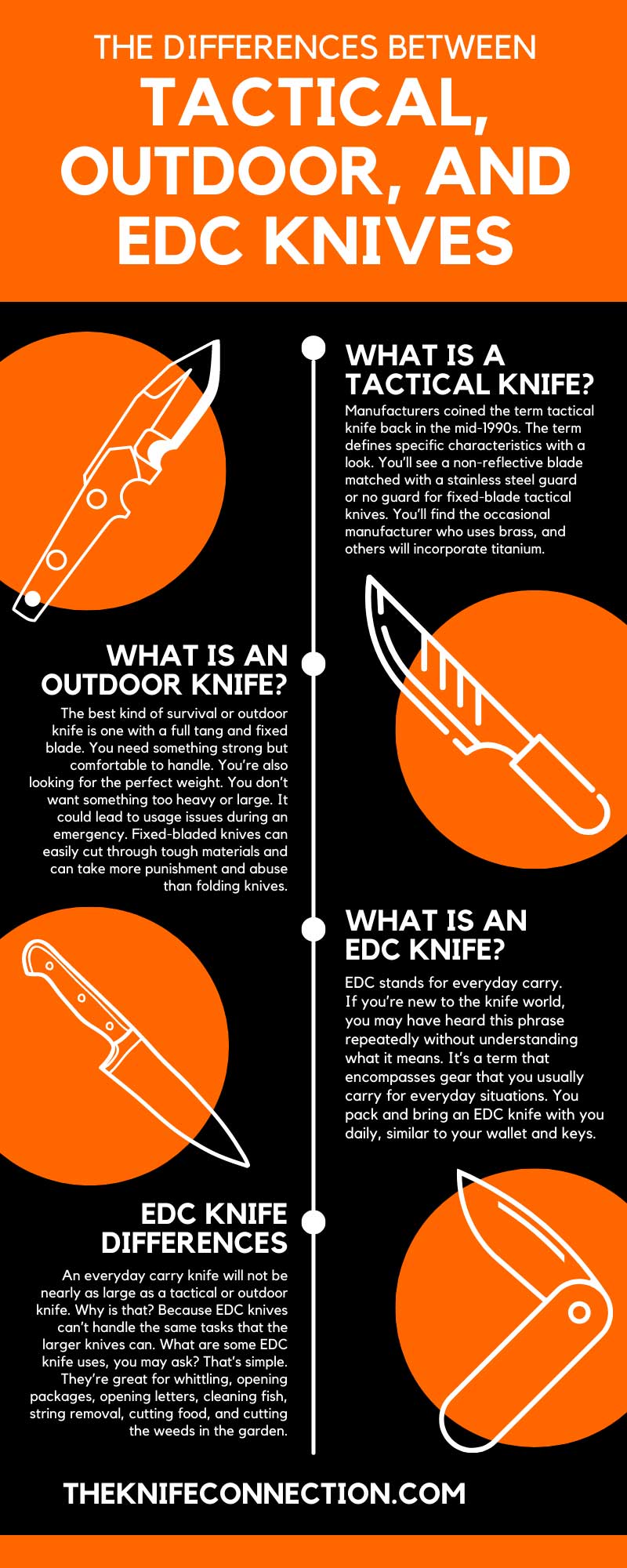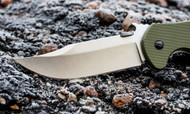The Differences Between Tactical, Outdoor, and EDC Knives
May 8 2023 - 7:17
Plenty of knife types are available on the market, so it can be challenging to determine which one is right for you. Don’t worry. This blog post will help you discover the differences between a few common ones. These types include tactical, outdoor, and EDC knives. Continue reading to learn more.
What Is a Tactical Knife?
Manufacturers coined the term tactical knife back in the mid-1990s. The term defines specific characteristics with a look. You’ll see a non-reflective blade matched with a stainless steel guard or no guard for fixed-blade tactical knives. You’ll find the occasional manufacturer who uses brass, and others will incorporate titanium.
Grip materials have changed from leather and wood washers to synthetic products. Micarta has become incredibly popular in the knife industry. Another material, carbon fiber, has also become more widely used in years past.
Several methods create the non-reflective blade that’s synonymous with a tactical knife. The most common process is the belt satin finish. It gives the blade a gorgeous sheen without being reflective. Sandblasting is another method that provides a non-reflective blade, but this process led to some technical problems. Since micro pits would form on the blade from the sand, water would become stuck in the pits leading to rust.
What Is an Outdoor Knife?
You may know this knife type by a different name, a survival knife. A good outdoor knife can be your best friend while camping, tackling yardwork, or exploring the great outdoors. It can help you prep food, collect fire tinder, and save your life when necessary.
Since there are various uses for an outdoor or survival knife, you must ensure you choose the right kind. It all comes down to what you plan to use the knife for. Do you need a knife that can handle multiple tasks while camping? Are you looking for something small to use to prep food during camping trips? What about something that can fit in your tackle box for fishing trips?
The best kind of survival or outdoor knife is one with a full tang and fixed blade. You need something strong but comfortable to handle. You’re also looking for the perfect weight. You don’t want something too heavy or large. It could lead to usage issues during an emergency. Fixed-bladed knives can easily cut through tough materials and can take more punishment and abuse than folding knives.
What Is an EDC Knife?
EDC stands for everyday carry. If you’re new to the knife world, you may have heard this phrase repeatedly without understanding what it means. It’s a term that encompasses gear that you usually carry for everyday situations. You pack and bring an EDC knife with you daily, similar to your wallet and keys.
EDC knives are typically lightweight, compact, durable, and usually multi-functional. They’re easy to store in a pocket, bag, or purse, so you can quickly access the knife when needed. In other words, it packs a punch without taking up much room.
It’s the perfect knife option for people needing a reliable knife for their daily lives. They can come in handy to cut a string from your shirt, remove a splinter, or mark wood. You’ll be glad you have an EDC knife around in an emergency.
Tactical vs. Outdoor Knives
Even though there are some similarities between the two, there are some standard differences between tactical and outdoor knives. Design is the biggest difference. You’ll spot multiple small things in specific areas, like the guard, blade, and handle.
Both tactical and survival knives can have folding or fixed blades. Typically, full-tang fixed blades are best for either option. They’re sturdier and stronger than folding blades, and that’s what you need when you find yourself in an emergency situation or attempting to cut through thick materials.
Handle Differences
Handles are all about personal preference. You won’t find them separated into sections where one is better for a tactical knife than an outdoor one. With this in mind, you want to look for key specifications to improve your specific knife.
Look for tactical knife handles made from materials that won’t cause you to lose your grip when wet or bloody. The texture is typically rougher to help you securely handle the knife. Another feature you’ll want on your tactical knife is finger grooves. You know you can achieve a firm grip, and your hand will stay in place.
Survival knife handles can feature the same advantages but for different reasons. The handle texture won’t be as aggressive because outdoor knife users don’t use them for the same rigorous activities. Even a smooth handle on your survival knife will do.
If you’re looking for a high-quality handle for your tactical or survival knife, use ESEE knife handles. They’re a trusted brand that knife enthusiasts have turned to for years. The Knife Connection has an incredible selection of styles, designs, and colors, ensuring our customers will find the right fit.
Guard Differences
Outdoor knives usually have a small guard because they can get in the way while in use. You’ll find that most tactical knives don’t have guards for that exact reason.
Blade Differences
There are more blade differences between tactical and outdoor knives than anything else. You’ll see different blade widths, lengths, points, shapes, and steel.
The tactical knife design makes it perfect for utility work, but it’s also a knife that you can fight with. A thin blade won’t hold up in a fight against a bear or other large creature. Most tactical knife blades can withstand corrosion and eliminate reflection. Nobody wants to be in the middle of a task and have to worry about being blinded by the blade.
A survival knife has a broader range of uses, but fighting isn’t one of them. It means you only need to worry about purchasing the best tool possible. The blade will be strong, but it doesn’t have to be as strong as tactical knife blades.
EDC Knife Differences
An everyday carry knife will not be nearly as large as a tactical or outdoor knife. Why is that? Because EDC knives can’t handle the same tasks that the larger knives can. What are some EDC knife uses, you may ask? That’s simple. They’re great for whittling, opening packages, opening letters, cleaning fish, string removal, cutting food, and cutting the weeds in the garden.
The most common EDC knife is a pocket knife. It’s easy to carry around in a pocket, purse, or bag.
It’s easy to spot the differences between an EDC knife and a tactical and outdoor knife. Refer to this blog when you’re stuck choosing between a survival and tactical knife. It will help you determine which one is best.

